Ecosystem analysis: Benefits of Biological Nitrogen Fixation in Plants to Shift towards Natural Farming
An essential process plant needs to grow and complete its life cycle is nitrogen from nitrogen fixation. They are as building blocks in plant biosynthesis. The overuse of chemical source of fertilizer like ammonium nitrate, urea, ammonium sulfate and other fertilizer as sources has made our plants and environment artificial management demanding. But in an ecosystem, a natural mechanism known as nitrogen fixation occurs in association with microbes to convert N2 to NH4 and NO3 to available forms for plants. Added with these, the other sources of nutrients such as phosphorus, potassium, sulfate, and micronutrients all come from chemical and biochemically made sources. Today, even a layman understands that our entire dependence on chemicals is a hazard to health and environment. Ecosystem analysts are beginning to advise agriculturist and farmers to move away to alternative sources. The benefits of biological nitrogen fixation plants have drawn wide attention in reducing nitrogen use.
What do we mean by nitrogen fixation?
The fact about benefits of biological nitrogen-fixing plants will only be convincing when we know what is meant by nitrogen fixation. Nitrogen fixation is an age-old process by which Earth’s atmospheric nitrogen (N2) is changed into ammonia (NH4) or nitrate (NO3) other molecular forms. This change occurring in nature is called biological nitrogen fixation (BNF); the process occurs with the help of nitrogenase enzyme and incorporated into specific plants. The fixation process frees nitrogen atoms from their triple bonded diatomic form, N2-NH4-NO3 forms for biosynthesis to amino acid and protein in plants.
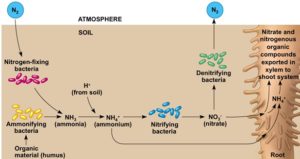
Figure 1: Diagrammatic view on how atmospheric nitrogen fixation occurs in the soil
How does Biological nitrogen fixation occur?
Nitrogen fixation occurs the help of a specific group of microorganisms either free-living or in living in association with other microbes known as diazotrophs. These contain microbial genes essential for nitrogen fixation as shown in the diagram above. They are either photosynthetic or non-photosynthetic. The free-living microorganisms use their energy (adenosine triphosphate-ATP) required for the process to convert N2. The photosynthetic organisms such as cyanobacteria enter into symbiosis and use sugars produced by photosynthesis in the plants. A symbiosis meaning a mutually beneficial relationship occurring between living organism results in the host plants rhizosphere or in root nodules. Therefore, nitrogen fixation can occur with associations outside the plant or inside the root cortex. What is modulus nitrogen fixation?
Biological Nitrogen fixation in root nodules
Nodulous nitrogen fixation occurs in the root cortex that forms protruding organs called nodules. Root nodules are swellings on a root containing rhizobia- a symbiotic bacterium inside the leguminous plant. Rhizobia are nitrogen-fixing bacteria that contain nitrogenase enzyme able to fix atmospheric nitrogen i.e. N2 to NH4 to NO3. The root exudates or chemicals attract bacteria of soil to enter the root cortex. The cells grow and swell out of root surface to look like nodes of different sizes. The conversion of nitrogen N2 reduction to NH4 and NO3 occurs through the enzymatic or symbiotic process. Within nodules inside the cortex of the root systems, nitrogen compounds produced help the plant to grow and compete for their functions (Figure 2 ). When the plant dies, the roots can be mixed into the soil by tilling. The fixed nitrogen contained in the nodules or bulbous organs come out and aid in fertilization of the soil. Therefore, nodulous roots never should be burnt or destroyed but put in back to the soil where other crops will be cultivated.
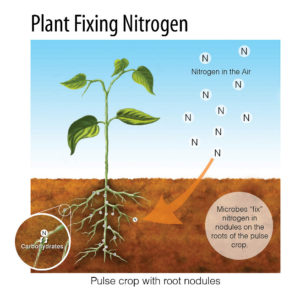
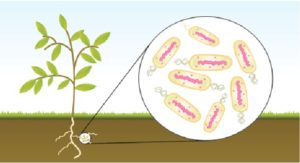
Figure 2: Root nodules contain bacteria called rhizobium or nitrifying bacteria which help nitrogen fixation
What are the nitrogen-fixing plants?
Nitrogen fixing plants are generally of two types-leguminous and non-leguminous. Knowledge and identification of both types is important to incorporate and harness the type appropriate to the ecosystem
Biological nitrogen fixation by leguminous plants
Nitrogen fixing plants can be leguminous or non-leguminous. The leguminous plants belong to the Fabaceae family or widely known as Leguminosae family. These plants have fruits in the form of pods, and root nodules discussed above. The nodules formed make them unique reservoirs of nitrogen. Agro ecologists, therefore, suggest mixing the dead roots of the harvested crop to incorporate the nitrogen inside the nodules. The examples of such plants are beans, peas, clover, alfalfa, acacia, mimosa, lentils, sesbania, phaseolus flowers, climbers and many trees.
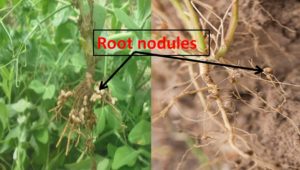
Figure 3 Nitrogen-fixing nodules in leguminous plants help nitrogen fixation
Biological Nitrogen fixation by non-leguminous plants
The leguminous plant’s benefits in acquiring nitrogen and nutrients free from the natural source. Sometimes the bacteria and microbes live in association in the soil and penetrate the plant in the available form. Wheat, rice, maize, millet, sugarcane, sorghum associated with diazotrophs or useful microorganisms such as azospirillum, Pseudomonas, acetobacter, and supply nitrogen to the soil rhizosphere to be taken up by the plant (Figure 4).

Figure 4: The rhizosphere of plants harbor microorganisms that also solubilize and make other nutrients available
Recently, a non-leguminous species of plant of the Genus Parasponia and family Cannabaceae display effectiveness of high nitrogen-fixing ability. These plants also have the potential of nitrogen fixation by nodule formation (Figure 5).
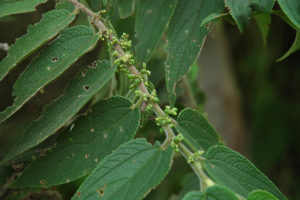
Figure 5: Nonleguminous plant of the genus Parasponia also helps nitrogen-fixation
Benefits of nitrogen fixation
The story of nitrogen fixation is useful and worthwhile only if we can use this mechanism to our benefit. As plants can take up only 40-45% of nitrogen from chemical sources, where do we think the rest comes from? It is the natural nitrogen sources.
The objective of this little thought is to praise the deeds of nature for the well-being of mankind. And, add facts on how nature provides both the major and minor elements to the ecosystem for selective uptake and application by particular species of plants. Yes, I said selective, because plants, crops, species all do not require the entire gamut of the element, neither do they use in equal proportions. The fact remains is there a concern. The answer is yes.
The concerns
Agroecologists and biologists are concerned on how we are spoiling the natural ecosystem by interfering with nature’s own mechanism. Indiscriminate use of fertilizer, pesticide to boost production is indeed killing, destroying and breaking the life cycles of the microbial population. Nitrogen of the upper hemisphere never reaches the ground due to obstruction of gaseous man-made pollutants. The conversion process in the soil hemisphere is disturbed by pesticides, garbage, factory wastes, slurry resulting in toxicity of the underground soil health. Food produced is therefore not safe.
Ecosystem analysis
So, here is an alert to keep our nature clean. Today we need to analyze our specific ecosystem to shift towards natural farming. Find alternatives to chemical farming. Experiment, apply, appreciate and share with our farming friends. Many of us do not know the reality of chemicals and how increasing diseases are grasping us due to poisoned food. Hopes still exist if we can use our knowledge and wisdom to produce enough nutritious food to feed the global population expected to reach 9.7 million by the year 2050.
Have a good day!
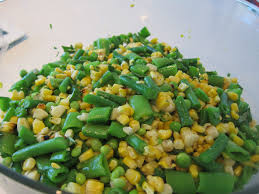
Sources of food dependent on nitrogen fixation


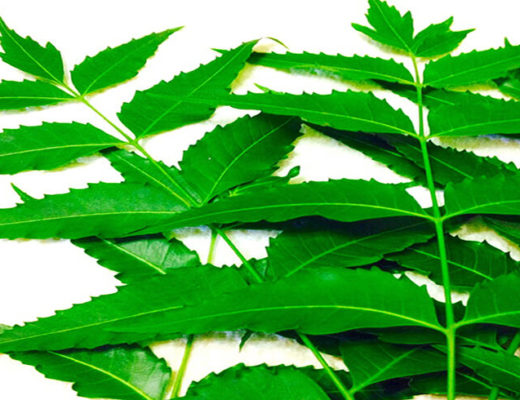
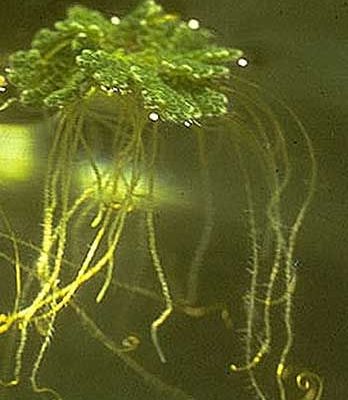
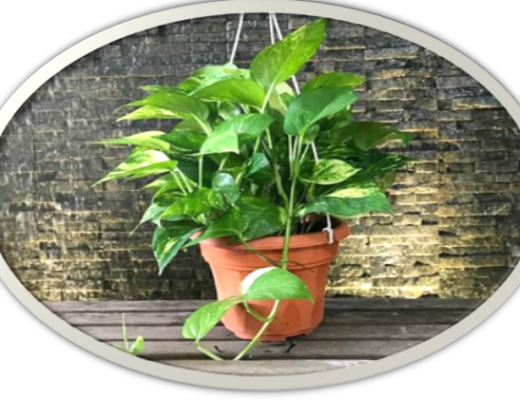
No Comments